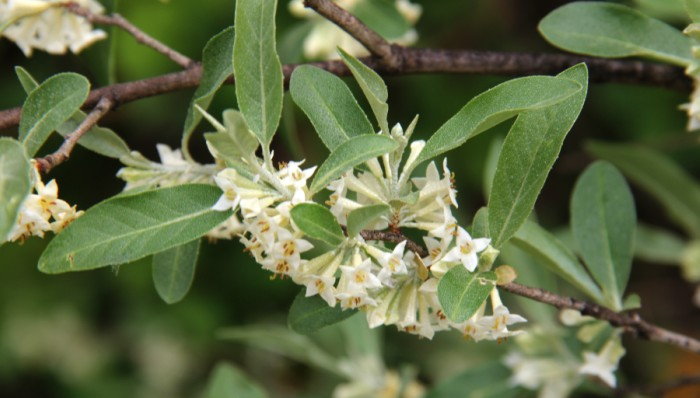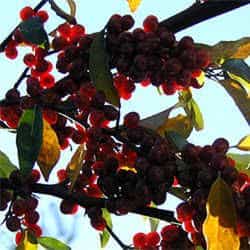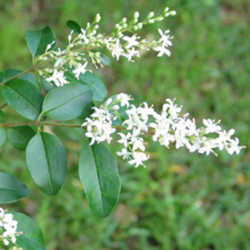It is Invasive Species Awareness Week and we're spotlighting some that are often offered for sale commercially. Many of these plants are attractive and easy to grow.
The autumn olive is often mistaken for a good garden plant
Elaeagnus umblellata, also known as the autumn olive, silverberry or autumnberry is an attractive shrub or small tree, that at first glance seems like a good fit for many gardens. The leaves provide visual interest with their attractive, silvery undersides, while the hundreds of tiny yellowish blooms are fragrant and attract bees and butterflies. But the real draw are the branches full of small red fruits that ripen in late fall that bear no resemblance to an actual olive and is not related to Olea europaea. Wildlife adore them and most people think this is a good thing.
This plant was introduced into North America in 1830 from Asia. Selling points described an easy to grow, attractive shrub that helped with erosion control and was attractive to wildlife. It was planted along roadways, in areas deforested by fire and in regions impacted by strip mines and people loved it. We also used the autumn olive as natural windbreaks from Florida, to well up into Canada. While it might freeze to the ground in the coldest areas, the roots are tough and hardy, so it always re-sprouts. However, sometimes you can get too much of a good thing.
Wildlife adore the plentiful red berries
Birds adore the thousands of red berries that ripen each fall and many species find them tasty. The seeds have an amazing germination rate that can reach up to 90% in receptive regions. My home state of Kentucky and neighbor Tennessee are two places where this is possible and we have a massive problem where autumn olives grow. They out-compete many native plants with shade and soon take over where allowed to grow freely. This applies to forest understory areas as well as open fields, because it is shade tolerant and can even survive there, which crowds out some of our less aggressive understory favorites such as dogwoods and redbuds. In open areas, these drought-tolerant shrubs quickly become the dominate species and since the roots fix nitrogen to the soil like legumes do, this creates an inhospitable environment for some of our native plants that thrive in less fertile conditions.

Techniques to remove autumn olive
You might decide to go on a cutting rampage and shear these bushes to the ground, but that won't solve the problem. Cutting simply stimulates growth and they happily sprout again to continue their march across the prairie. However, one method of removal does involve cutting them. The shrubs are cut to the ground and the stumps painted with full-strength glyphosate. When they inevitably sprout some new growth anyway, the new stems are sprayed with the same chemical before they can harden. This is definitely not an ideal situation, knowing the problems glyphosate produces in our streams and rivers, but it may be the best solution in areas of heavy infestation. The only other solution is to physically dig the plants, roots and all, and burn them.
Autumn olive berries are edible
However, there is an up side to this invasive. The small red berries are edible for humans and are actually quite nutritious. They contain one of the highest concentrations of cancer killing lycopene known, with between 40 and 50 mg as opposed to 3 mg in tomatoes. It is a great source of fatty acids (which is unusual for a fruit) and has high concentrations of Vitamins A,C, and E. Cooking the fruit to extract the pulp kills the seeds, so they can be composted without fear of creating an impenetrable jungle. Plus, for every berry you harvest, that's potentially one plant that won't live to produce more seeds. Bushes mature to seed-producing size in about 3 years, so stripping the berries could make an impact in your area. There are a number of blogs with recipes for jams, pies and other tasty treats. The taste is similar to a cranberry or pomegranate but the unripe fruits are astringent, similar to a persimmon. They ripen in late fall, so would be one of the last wild-harvested crops you can find. There are several entrepreneurs who are starting to recognize the usefulness of this plant and are working on harvesting and processing methods to bring its fruit to the public.
Autumn olives were part of the Asian herbal pharmacy
The autumn olive is used in Asian folk medicine with flowers and leaves brewed into a tea that is effective against E. coli and the roots were ground as a treatment for syphilis. The seeds produce an oil that loosens bronchial secretions and contribute to an herbal cough syrup, so it isn't all bad, it simply has no natural enemies here in North America. Bugs don't bother it and deer don't browse the shrubs, so it can spread as fast and far as the birds can fly.
Autumn olives are still sold commercially, so beware!
Many garden centers and nurseries are still selling Elaeagnus umblellata and its equally invasive cousin Elaeagnus angustifoilia (Russian olive) so please be aware that you may see it for sale even though it is on many invasive species lists throughout North America. It is considered a severe threat in Kentucky and Tennessee, but is still considered noxious in even the Pacific Northwest and Hawaii. There are a number of native alternatives that gardeners can choose instead. Native Ilex (hollies) Cornus (dogwood) and Viburnums all provide wildlife forage and garden interest without threatening the environment. It is up to us to be responsible and make wise decisions on what we plant.


















